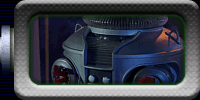My
brother and I began working on a scratch built robot, together.
We came up with a fairly inexpensive way to make a torso out
of fiber glass that skips the steps of making a plug first.
I actually got the idea from seeing how Mike Joyce made his
first plug. The idea of scraping the domes out of plaster got
me to thinking that the whole thing could be made that way.
The first
thing that we did was cut a “paddle” out of an old
discarded stop sign that was rescued from the trash. It was
ideal because it was easy to cut. It was very rigid. And it
did not rust. (It must be washed throughout the process). Whatever
you choose for a material, it will have to withstand some force
without bending. We traced the club blue-prints to make one
half of the torso. The plastic pipe that you see on the end
was actually sliced down one side and the metal slides into
it. Therefore you must add ½ of the inside diameter of
the pipe to the metal paddle to make sure that the center line
of the paddle is in the center of the pipe.



(Note; the
bolts that you see are because after we got it done, we were
not happy with the corners of the grooves. We cut new pieces
and bolted them on the back. We also added wings to the side
to carve out the holes on the ends.
The handle
turned out to be too flimsy to be of any use. I would suggest
drilling finger holes in it. It is easy to push down, but when
you get past half way, it is hard to reach around to push up.
Putting a finger in a hole and pulling up would be helpful.
Lastly,
when you slide the pipe on, do not cut it to length until after
the forms are done. You want to make sure that it is centered
in the form, then mark where the end caps will hold it firm
against the outside of the form).
To build
the forms, we went to Home Depot and got two “handy panels”
(2’X4’) of ¾” MDF and two panels of
1/8” hardboard, smooth on one side, and rough on the other.
You will need four half circles cut out of the MDF with a 30”
diameter. They each need to have one half of a hole in the center,
the size of the outside of your PVC pipe. It is easiest to clamp
the panels together before you cut them and drill right into
the seam between them.
The hardboard
panels do not even need to be cut. They are about 1/8”
too long, but I just sanded that off the top with a belt sander
after they were assembled. I used small nails and just nailed
them around the curves. You can see in the picture that I used
some scrap strapping to make legs, and secure the ends with
the help of a few corner brackets. I also screwed three 22 ½”
- 2 x 2s in between the sides to space them out while I assembled
it, and took them out afterwards.


Before you
start the plastering, consider this, the molds will get heavy
and somewhat fragile. You can see in some of the later pictures
that we have a bar clamp across the top of one of them. We tried
to move it and it began to crack. Luckily the clamp pulled it
back together. You will probably want to fiberglass outside.
You should find a convenient place to put the molds where they
can stay start to finish. We were lucky enough to have a spot
outdoors, but under a roof where they were protected from the
weather.
We ended
up using five, five gallon buckets of lightweight joint compound.
Perhaps mixing up bags of plaster might be cheaper, but for
about $65.00 this worked quite well for us. As a shortcut, we
stuck a Styrofoam pool noodle into each side of one of the molds
to take up some of the space along the curve where plaster would
have been several inches thick. In the second mold, we used
expanding foam insulation. Both worked about as well. Just make
sure that you leave at least an inch between the paddle and
the foam so that the plaster will not be too thin.
You can
coat the mold with a good inch or two of plaster for the first
layers. Then just run the paddle through it in one swipe. What
it scoops out, you can just scrape off and throw it back in
the bucket. As the first layers dry (it might take a few days)
they will shrink and crack something awful. Do not worry about
it. Your last coats will be much thinner, eventually just filling
in small holes and gaps. You will reach the point when the paddle
will do no more. Now you can go over it with a wet sponge smoothing
it, taking off any high spots and filling in any holes. When
it is ready, paint it with gloss paint. This will seal it and
smooth it as well. After painting, you might notice some spots
that you are not happy with. You can still sand, or fill as
needed and paint over it.
The better
the mold is, the better the part will be. Obviously it is easier
to smooth plaster than sand fiberglass, but fussing with the
mold too much runs the risk of destroying it. You will not get
it perfect.




To incorporate
the neon hole, and arm holes into the mold we went back to Home
Depot, and bought some foam panels that are meant to go on a
floor. They are about two feet square. They are smooth on one
side and diamond plate on the other. The edges fit together
like a jigsaw puzzle. For the neon we cut one to shape and glued
it into the curve. We then put a second layer over it. Obviously
it had to be trimmed smaller because it was the inside of the
curve. We put this one in smooth side up. We then used wood
putty to smooth the edges and fill in the groove underneath
it. The arm holes, as you can see are just a single layer.


I won’t
go into too much detail on the fiber-glassing. This is already
getting quite long. There are a lot of tutorials on the web.
I will just say this much. The mold must be waxed. After the
first coat of resin, we filled the grooves with Bondo before
putting in the cloth. We used a layer of medium cloth, then
a layer that consisted of ‘roven woven” stitched
to a layer of matting. For resin, we used polyester molding
resin (about two gallons). The parts ended up being about 3/8”
thick, but extremely rigid. I would strongly suggest getting
some pointers on the web before starting. That is what we did.



We had hoped
to get the parts out leaving the molds intact, but we really
did not expect it. The day we tried, it was pouring rain. Although
they were out of the weather, the humidity made the plaster
that much softer. We just pulled them apart and scraped pounds
of mushy plaster and stringy paint off with putty knives.
At this
point, we have trimmed the halves, fiber-glassed them together
from the inside, and begun working on sanding, and smoothing
with Bondo. The arm sockets and the molding still need to be
put in as well. Although there is still a long way to go, I
have to say that to this point; we have not put in a lot of
time or money to get a pretty good start on a light weight,
solid torso.




Updated:
10/23/2012:
It
has been a long time but the torso is about finished. It did
not come out perfect, but for scratch built, I am pretty happy
with it. After the arm sockets were fiber-glassed in, it only
took about three metric tons of Bondo, two million sheets of
sandpaper, and a fifty-five gallon drum of red putty to finish
it off. (Or something like that). We primed it, and used a textured
silver paint, followed by a light clear coat. The picture does
not show it well, but it has a cast aluminum look to it. I am
not sure how that jives with the original, but that is how both
my brother and I remember thinking it looked when we watched
the show all those years ago.
As I said,
it is not perfect, but the overall dimensions should be within
a fraction of an inch. The details would look OK to the average
eye. In the end, we saved some money. But more importantly,
it was quite a challenge. That is really why we do this, isn’t
it?
Although
it has taken a long time, we did not work steadily on it by
any means. If there is someone else out there who is considering
scratch building, I would recommend giving this approach some
thought.
So,
on to the rest of the robot…




We’ll
keep you posted…
















